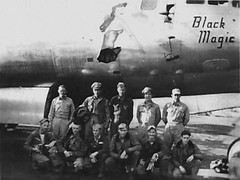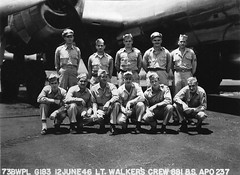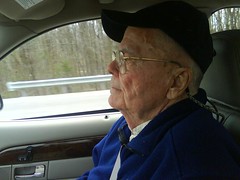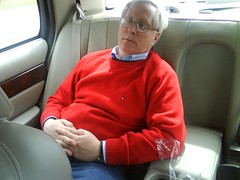Four years ago, on Father's Day, my youngest sister E* had breakfast with him in St. Louis. He had turned 80 years old, and was in a talkative mood. He expressed how lonely he was, because most of his friends had died. He began to reminisce about the war years, and told my sister the names of the men with whom he served. His memory isn't very good, due to a stroke. But he can remember the 1940's like it was yesterday. My sister, realizing the significance of this trip down memory lane, took notes.
In 1943, when my father was 20 years old, he enlisted in Navy flight school. He had to pass one final test to complete his training and become a Navy fighter pilot: the dreaded "circle test." In this test, designed to simulate carrier landings, student pilots were required to set the training aircraft down, tail-first, in a 100-foot diameter circle painted on the landing strip. Unfortunately, my father had developed a sinus infection. He could have reported in sick, but he would have missed his opportunity to graduate from flight school. Instead, he tried to take the test sick. He failed, and was discharged from the Navy.
He immediately enlisted in the Army Air Force (the Air Force as we know it today had not yet been created), and trained to become a bombardier, eventually serving abord the state of the art B-29 bomber on the island of Saipan in the Pacific as part of the 73rd Bomb Wing, 500th Bomb Group, 881st Squadron. His aircraft was named "Black Magic," and it carried a crew of 11: a Pilot (known as the Flight Commander), a Co-Pilot (who actually flew the plane and did all the paperwork), a Flight engineer, a Navigator, a Radar operator, a Radio operator, a Chief Gunner, two Waist Gunners, a Tail Gunner, and a Bombardier.
My father’s crew was the third crew of this aircraft, which by that time had flown more missions than most other B-29 bombers on Saipan. Crews were rotated back to the States when they completed a minimum of 15 missions. However, during my father's tour of duty, with Japan's military close to collapse, the minimum number of missions was raised to 35. My father's crew completed fourteen bombing missions before the atomic bomb ended the war, and two more relief missions. Here’s a picture of the Black Magic, with the second of its three crews:

Like most bombers of that time, it had a girlie picture on the nose. By the time my father arrived, however, the image had been removed, because some uptight female congresswoman had been offended. All of the planes on Saipan were ordered to be cleaned of such images, despite the fact that the men they carried were risking their lives so that she could keep her job.
Here’s my father’s crew. He’s the second from the right in the back row:

When my sister returned home to Arizona, she got online and started a research project that took months to complete. She eventually tracked down six surviving crew members, and family members of others who have passed away. After some communication, they agreed to a reunion in Dayton, Ohio in November, 2004 - the first time they had seen one another in 57 years.
I missed this reunion, but it was a huge success. The men renewed their acquaintances as though they had seen one another only last week. Spouses and children came along, turning the event into a large party. The crew spoke of that time with unrestrained candor, and my sister got to hear it all.
She had arranged to tour the National Museum of the United States Air Force in Dayton, where the fully restored "Bockscar" B-29 is on display. It's one of a very few remaining in the world, most having been sold for scrap after the war. General Gregory “Speedy” Martin (a four-star general) agreed to meet the men, which was a huge thrill for them. My father is the one on the far left:

Sadly, the brief reunion came to an end. The men were all in their 80’s, and they realize that time is running out for such things, so they expressed great interest in another one as soon as possible.
After four years, the Radar operator, Dean B* and his wife made arrangements to host another reunion in their home state of Tennessee. There was no way I was going to miss this one. So last week I flew to St. Louis and rented a big Mercury Grand Marquis. My brother-in-law L* and I picked up my dad and we hit the road for the 8-hour drive to the Knoxville area. My father was giddy with excitement, but at his age, giddy doesn’t look much different than any other emotion.

My brother-in-law was less giddy, bordering on comatose:

I’ll write more about the reunion after this wave of giddiness wears off.

10 comments:
Didn't Bockscar drop Fat Man on Nagasaki?
That was cool of your sister to do all that.
Yes, the "Bockscar" B-29 did drop the second atomic bomb on Japan, which is one reason why this particular aircraft has been so painstakingly preserved in the Air Force Museum.
However, one of the crew members noticed that some modifications have been made. The B-29 was built by Boeing, and many of the components (such as the control surfaces and the bomb bay doors) were operated by electric motors, typical of Boeing. But during the restoration process, someone decided that hydraulics were more reliable, so many of the original electric actuators have been replaced with hydraulic cylinders. This is something most people wouldn't notice, but it's a testament to how sharp these old guys are that they spotted it.
What a love story, Tim.
Tim, Thanks for this post and all future ones. I missed this trip, and your commentary will be good as I miss these guys. They are all wonderful men.... and I just adore them all.
E*
Tim, I appreciate you recording all of this. It was a great time in history and a great time at the reunion. I am honored to have been a part.
Jan B*
Thank you for sharing this story. My grandfather Hank Bartolo was the co-pilot. They called him "Little Chief". He was second from the left in the old photo with the plane and second from the right in the "Boxcar" photo. His memories of the crew and his time with them were second only to the love he had for his family. He passed away on 18 July 2008.
You did a beautiful job writing this account. It truly honors the crew of the Blackmagic. Thank you, Scott Bartolo
This was a great article. My father, Hank Lanzoni was the flight commander of the original Black Magic..top picture. He passed away at 41 due to cancer, still serving in the Air Force. I am his oldest son now 66 and attempting to learn of his military war experience. I enjoyed your story and hope to learn more. Regards, Greg Lanzoni
I think your father's plane dropped supplies to a POW camp my father was in. A note was dropped by Col CR O'Donnell - do you know if he was crew on your father's aircraft? Black Magic and Z 24 also mentioned
The tail gunner in my father's crew was named Bob O'Donnell, but he wasn't a Colonel.
My Grandfather was part of the BlackMagic crew....does anybody have a full pic of the nose art?
Post a Comment